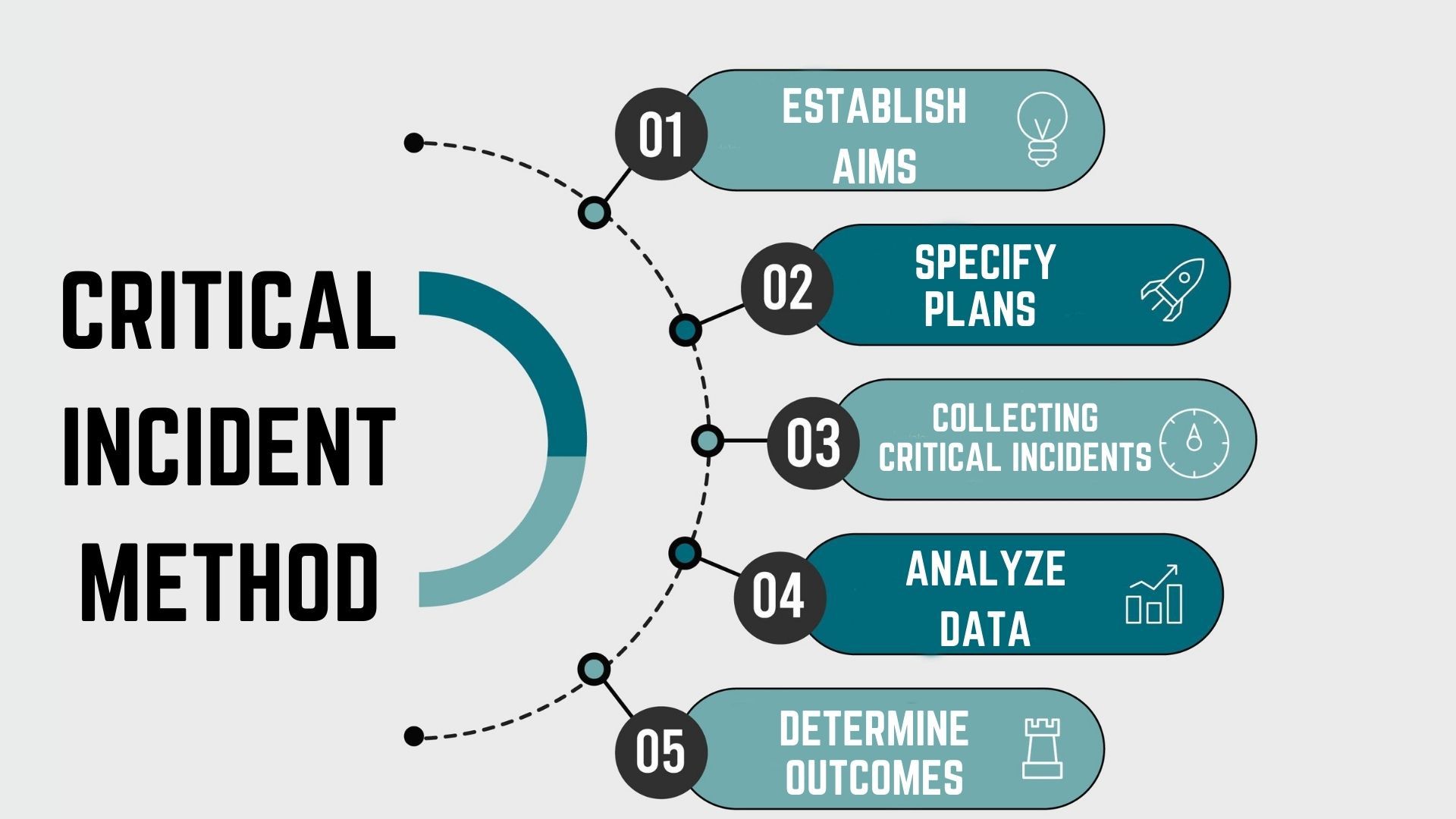The critical incident method, also known as the critical incident technique, is a process that uses a set of procedures to collect, observe, and analyze human behavior at specific events where an employee or an individual performs well and the circumstances where he could have performed better. It is a useful tool for performance appraisal
In the critical incident technique, the observer keeps a vigilant eye on the critical human behavior, incidents that occur, and the skills that an employee uses in the workplace. The manager provides a detailed critical incident report, which is later used to develop psychological principles and tackle practical problems.
Table of Contents
The five-stage process of critical incident method

The critical incident technique is a five-stage process that has the following steps
1. Establish aims
The first stage establishes the aims of the activity. It lays down the groundwork that will determine what comes under the critical incident. This step involves identifying and reviewing the incidents that have occurred during the job.
An incident includes an account of what took place either through direct experience or observing the participant, for instance, a manager giving an account of what he saw. Some organizations like to help experts in defining the aim, especially those of activities that are not directly supervised by managers.
2. Specify plans and conditions
The second step of the five-stage critical incident technique is about laying down the conditions related to the general aims and plans for collecting incidents. The situations that have to be observed, who will be entrusted with the observation, and most importantly, who is being observed are all defined in clear terms.
An important step in this section is determining the best person for the job of providing incidents. He must be familiar with behaviors and conditions to make a useful critical incident report
3. Collecting critical incidents or facts
This step involves gathering information and finding facts about the incident’s incident during the job. Many researchers look at the critical incident interview to gather oral accounts but gathering written accounts is also essential.
This step also specifies the number of incidents that must be collected.
4. Analyze data
This step involves analyzing the information, facts, and data that has been collected from the participants by the researcher and determine any resulting issues. Categories of the behavior relevant to the study and how they will be subsequently used are determined.
This step is considered an inductive process that groups patterns and compares statements.
5. Determine outcomes and evaluate solutions
The researcher goes through the information, interprets, and then reports the findings. This step involves identifying the possible solutions for the problems that have already been identified.
The last step is evaluating whether the solution will eliminate the root cause of the problem that was identified.
The critical incident technique of performance appraisal
The steps taken for the critical incident method performance appraisal are as follows-
- A manager needs to start the discussion with an employee on an upbeat note. A friendly greeting sets the tone for the session and induces positivity in the environment.
- Layout the groundwork for the performance appraisal and tell the employees about the topics you will be covering and the order in which they will be addressed in this session. This will encourage an optimistic setting with a positive exchange that will lead to fruitful results.
- The next step in this process is to ask relevant questions. The answers will help in eliminating and resolving any existing issues
- It becomes crucial for the manager to maintain the focus on the activity on hand. The feedback should also be focused on the employee’s performance and not any other subjective or irrelevant things. Talk about developing competencies, handling critical incidents, achieving results, and meting objectives if you want to make the session a complete success
- Talk with the employees on a one-to-one basis and discuss the evaluations. Give them specific information to avoid misunderstandings. Provide the rationale behind the ratings you have given. You can also discuss the points and understand where both of you are agreeing and where you disagree
- Performance evaluation does not mean giving your opinion and having your say. Active listening is an integral part of the process where the superior tries to understand what the employee has to say. Rephrase and summarize to understand the employee properly
- This is an excellent opportunity to discuss and clarify the overall ratings with the employees. Give them information about the specific criteria that you have used to determine the results. This will help to clear most of the doubts from their mindset, and they will be assured that there has been no bias during the process
- The last and most important part of a critical incident performance appraisal technique is to end the session on a positive note. The manager should summarize the discussion, highlight the key points, ask the employees to sign the evaluations, and set follow-up dates for goal-setting
Advantages
The advantages of the critical incident technique are as follows-
- Other methods put their onus on common events, whereas the critical incident report focuses on identifying rare events
- The critical incident analysis is considered advantageous as it provides important information
- It is a cost-effective method and is considered beneficial for an organization
- The perspective of the respondent is taken into account, and he is not forced to be a part of any framework related to the critical incident report
Disadvantages
The disadvantages of the critical incident technique are as follows-
- Several incidents are not reported for the simple reason that the observer might have forgotten them
- The reports might not be as precise as they should be
- The chance of bias is greater
- The incidents might not have taken place during the job and thus are meaningless
Conclusion
The critical incident method helps define the abilities, skills, knowledge, and competencies required for a task. It is especially helpful during job description and job specification as it aids in attracting the right talent for the job.
Liked this post? Check out the complete series on Human resources
